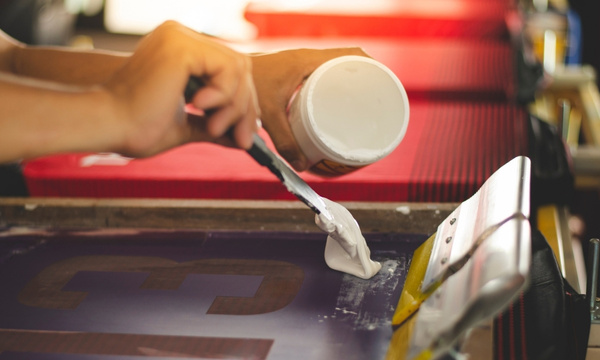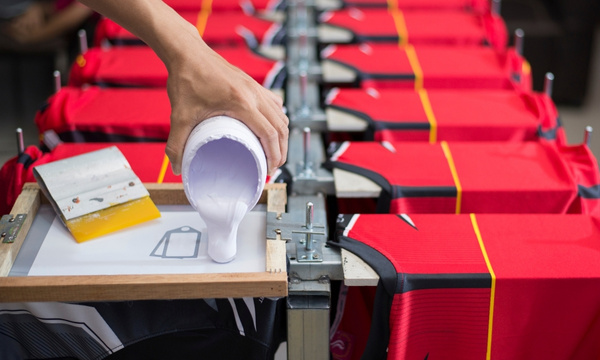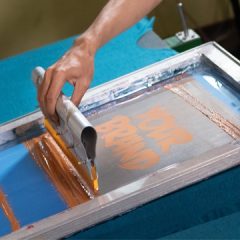You’ve always liked wearing polyester shirts since they’re durable and lightweight, so they’re ideal to wear when you’re playing sports.
The only thing that bothers you is that polyester shirts tend to be plain, so you’re thinking about customizing them through screen printing.
But since it’s a synthetic fabric, can you custom print on polyester?
This article will help you figure out what types of polyester fabrics are ideal for screen printing. So if you’re ready to add a bit of flair to your polyester shirts, read more below.
What is screen printing?

Screen printing is a method for transferring ink to suitable materials to give them a personalized touch. To create a custom print, you’ll need to transfer your design onto a stencil so you can press it with ink and a mesh screen.
Screen printing is popular for creating personalized shirts as it’s easy and quick, so it’s ideal for printing orders in bulk. The designs are also durable and lost-lasting, so they stay vibrant even through several machine washes.
It may take a bit of skill to create a high-quality print, so crafters often learn to make them by hand first before moving on to a machine.
Can screen prints go on any material?
Screen printing is a versatile technique that you can print on almost any surface, including fabric, wood, paper, and plastic.
But since you want to focus on screen printing shirts, cotton would be the ideal fabric to print on as it tends to absorb color well, making your designs appear vibrant.
But if you’re thinking about experimenting with synthetic fabrics, screen printing on polyester is possible; it’ll just be more challenging.
Since polyester is stretchy and nonporous, it won’t absorb color as good as cotton, so you’ll need to use special inks if you want to get a good print.
Natural and synthetic blends are easier to work with as they tend to have the best of both worlds, where they’re absorbent and more durable than other types of fabrics.
Can you print on polyester fabric?

Now that you know that screen printing on polyester fabric is possible, let’s explore which blend is best to get the perfect print:
Can you screen print on 100% polyester?
Screen printing on a 100% polyester shirt can have a lot of creative potential, like making team shirts that would look great on your next sports match.
But since polyester contains synthetic materials, you will face a few challenges if you don’t tailor your materials to fit the fabric.
For instance, the dye on darker-colored polyester shirts tends to transfer onto your screen printing ink when exposed to higher temperatures above 300°F (148°C). So white ink on a black polyester shirt will appear gray if you don’t change the type of ink you’re using.
To avoid this, pros will switch to a low-cure ink or use an under-base to prevent the dye from migrating.
100% polyester fabrics are also prone to burning, so you’ll need to keep a close eye on your shirt when flash curing to avoid scorch marks.
Can you screen print on 50% cotton 50% polyester?
A shirt with a 50% cotton and 50% polyester blend will be much more forgiving than a pure polyester fabric as it’s more absorbent, making your designs appear more vibrant.
Although darker-colored shirts will be less likely to bleed into your inks, if you want to keep it safe, you can use a low cure ink or a low bleed polyester ink. So make sure to test out which type and brand will work best on your shirt.
Since you need to keep the curing temperature low when curing, applying a thin layer of ink when pressing will help minimize the dye from migrating.
Can you screen print on 60% cotton 40% polyester?
A 60/40 cotton-poly blend is softer and more breathable than a 50/50 shirt blend.
But since it contains polyester, the dye will still tend to bleed into your ink when exposed to high heat.
So you’ll still need to use a low cure or low bleed polyester ink if you want to get vibrant designs.
Keeping your flash curing temperatures low will also prevent the dye from subliming. So, experiment with the time and temperature ratio that will work best on the ink and shirt you’re using.
Can you screen print on polyester spandex?
Screen printing on a polyester shirt is already a challenge, but adding spandex into the mix is a whole other ball game.
It is possible to screen print on a polyester spandex blend; you’ll just need to tailor your ink to make your designs appear better and last longer.
Since spandex will make your shirt stretchy, adding a stretching additive to your ink is recommended to make sure your design can withstand its elasticity.
Since polyester is also present in the fabric, using a low curing ink will also prevent any dye migration when you want to screen print on dark-colored shirts.
Can you screen print with plastisol ink on polyester?

Plastisol ink is the usual go-to for most screen printers because of its ease of usability.
You can use standard plastisol inks on white polyester shirts since you won’t have to deal with any dye migration.
But if you want to screen print on dark-colored polyester shirts, you’ll need to switch to a low cure or low bleed plastisol ink.
Applying a white plastisol ink as an underbase will also help make your colored inks appear more vibrant. Do some ink tests first to see which technique will work best for your polyester shirt.
Can you screen print with water-based ink on polyester?
Most screen printing professionals will tell you to use plastisol ink when printing on polyester shirts. But if you’re looking for an environmentally-friendly approach, try using water-based inks instead.
Screen printing water-based ink on polyester will make your designs feel softer and breathable, so they don’t tend to crack even after several washes.
Mixing a low cure catalyst into your ink is recommended to reduce the curing time and temperature to prevent any dye migration.
Using an underbase when printing on dark-colored polyester shirts is advisable, so colorful inks will appear brighter.
Can you do digital printing on polyester fabric?
Digital printing is great for more detailed designs that would be difficult to create through screen printing.
Since you’ll only need to load your design on a fabric printer, the process is less labor-intensive than transferring ink over a mesh screen.
So if you want to do a digital print on a polyester shirt, a Direct-to-Garment printer will give you the best results.
The printer can be pricey, but it’s a worthy investment if you have a t-shirt printing business.
It can take several trials to figure out the right setting for your ink and shirts, but once you do, the quality of the print will stay consistent throughout the printing process.
Can you do sublimation printing on polyester fabric?
One of the great things about sublimation printing is it allows you to press a design on the entirety of the shirt rather than sticking to the center.
Polyester and polyblend fabrics are actually the greatest candidates for this method as their polymers tend to open up once you expose the fabric to heat. This will allow the ink to penetrate deeply into the fabric. That’s why they don’t tend to fade.
So if you want to use this method on a polyester shirt, you’ll need sublimation paper and a heat press. Sublimation ink will work best at high temperatures, so you’ll need to set your heat press at 375-400°F (190-204°C) for 45-60 seconds to get a high-quality print.
Can you heat transfer on polyester?
Heat transfer is the most basic method for printing on shirts, so it’s no surprise if you can also do it on polyester shirts.
You just need to be careful to keep the temperature of your heat press below 300°F (148°C) to prevent your fabric from melting.
When pressing, putting a layer of cover paper or wax paper over your shirt will also help prevent any scorch marks from appearing.
To ensure you won’t burn your polyester shirts, you can press a small portion of your shirt at certain temperatures and increase it until scorch marks appear so you’ll know its heat limit.
Can you screen print on nylon?
Like polyester, nylon fabrics tend to melt when cured under higher temperatures. So to avoid this, you’ll need to mix in an additive to lower the curing temperature of your plastisol ink.
It’s best to keep your curing temperature below 300°F (148°C) to prevent scorching marks and discoloration.
Since nylon is slippery, it’s also a good idea to use a jacket hold-down to pin your garment flat to prevent your design from sliding around.
How to remove screen print from polyester?
Whether you made a mistake when screen printing or want to get rid of an old design, pure acetone will remove the ink on any polyester fabric.
You’ll need to pour some acetone on a cotton ball, rub it all over the print, and let it sit for a few minutes.
The ink will then start to peel, so you can scratch them off with your nails or apply more acetone.
On bigger designs, you can use a clothes iron and a paper bag to peel off your screen print design.
To start, lay a paper bag over the design and glide your clothes iron over it. The heat will make the design stick to the paper bag so you can easily peel it off.
But since it’s easy to melt off a polyester fabric, make sure to lift it off every couple of minutes.
Once most of the ink has transferred onto the paper bag, slowly peel it off your shirt and get another blank paper bag to remove the rest of the ink.




Leave a Reply